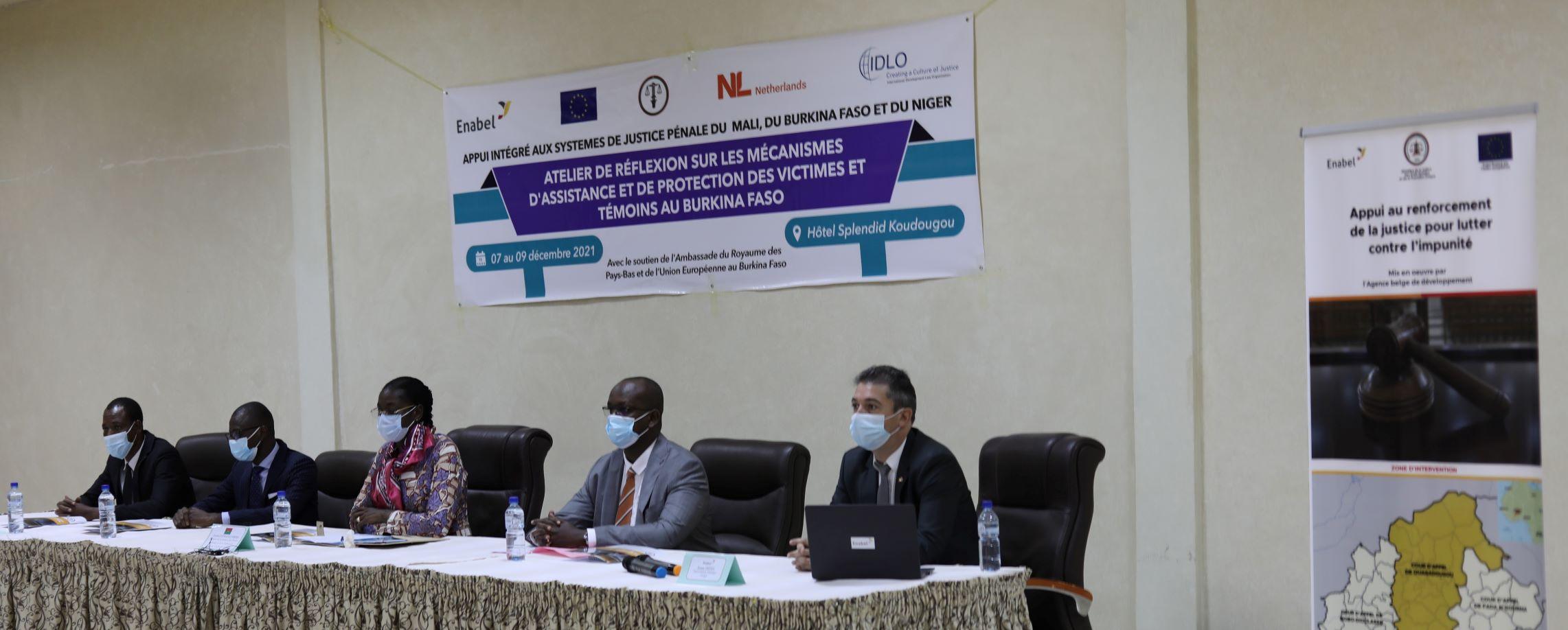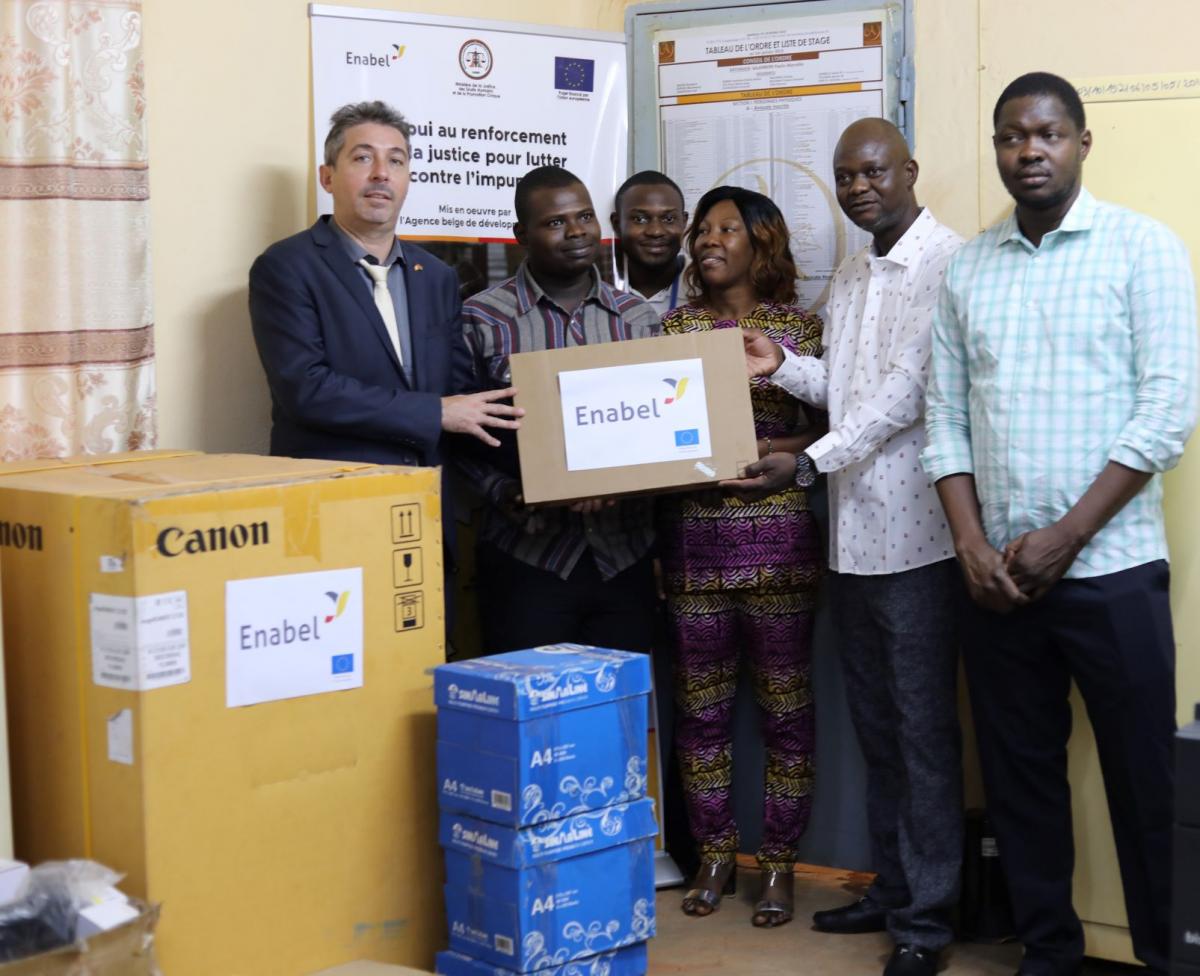Rechercher
Affichage de 1725 à 1740 sur 3076 actualités
-
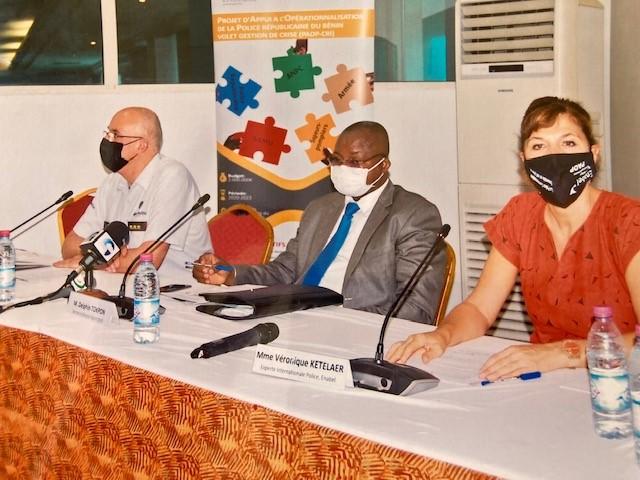
Au Bénin, un manuel multidisciplinaire de gestion de crise désormais disponible
Reece-hermine ADANWENON | 17/12/2021
En séminaire du 7 au 9 décembre 2021 à Cotonou, la cinquantaine de participants la plupart acteurs des secours, des soins, de la sécurité, de la protection et de la société civile, a procédé à la validation du manuel de gestion de crise multidisciplinaire. Cet atelier fut aussi l’occasion de souligner l’importance de communiquer ce document stratégique aux autorités administratives, judiciaires et élus locaux. Elaboré avec l’appui du Projet d’Appui à l’opérationnalisation de la police républicaine (PAOP) et son volet gestion de crise (PAOP-CRI), financé par l’Union Européenne et mis en œuvre par l’Agence belge de développement "Enabel", ce manuel doit rester un outil dynamique et adapté aux réalités de terrain.Le manuel de gestion de crise est un document qui vise à guider la réponse des forces de sécurité, les secours, les services médicaux et la protection civile en appui aux autorités civiles pour tout événement de crise, notamment les plus courants rencontrés au Bénin tels que les épidémies, les inondations, les incendies de forêt, les tempêtes et les sécheresses...La démarche qui a conduit à l’élaboration dudit document repose sur la définition d’indicateurs tactiques, opérationnels et stratégiques permettant notamment d’anticiper sur l’évolution de la crise et de proposer rapidement aux décideurs des scénarios de sortie de crise. Les crises intérieures les plus récentes auxquelles le pays a été confronté ont mis en évidence leurs aspects socio-économiques et le fait que leur résolution résultait bien souvent de la double implication des pouvoirs publics et des intervenants.Ce séminaire a permis de disposer de la dernière monture du document qui sera mise en œuvre par tous les acteurs de la gestion de crises qui ont d’ailleurs travaillé d’arrache-pied à l’élaboration dudit manuel.Le Bénin, en raison de sa situation géographique, économique et socio politique, peut être sujet à des situations d’urgence telles que les catastrophes naturelles, le terrorisme, la piraterie, les explosions, les épidémies, les conflits socio-politiques et autres actes de braquage. L’Agence belge de développement "Enabel" à travers son programme police a obtenu un financement de l’Union Européenne pour appuyer les structures de sécurité, de santé et de la protection civile dans la planification, la prévention et la gestion de probable crise au Bénin.
-
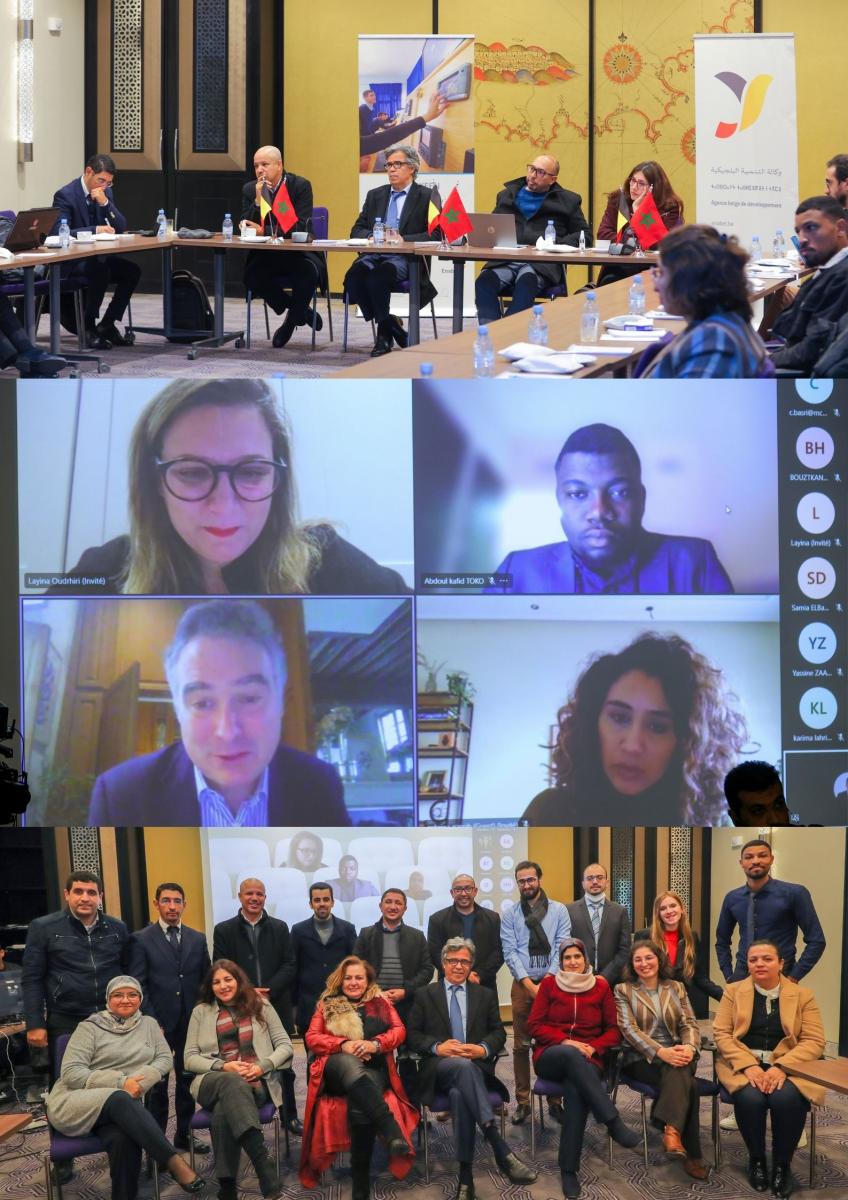
Maroc : Le rapport d'évaluation d'IDARATHON 2020 fait l'objet d'un premier atelier de restitution
Bénédicte BAZYN | 15/12/2021
L’aventure IDARATHON 2020 touche bientôt à sa fin et en vue de préparer le grand évènement de clôture de cet évènement unique, e-TAMKEEN a tenu un premier atelier de restitution du rapport d’évaluation de l’expérience. Celui-ci s’est tenu sous format hybride la matinée du 3 décembre 2021. Vendredi 3 décembre a eu lieu un atelier de restitution du premier rapport évaluant l’impact de la première édition d’IDARATHON. Organisé sous format hybride, à moitié en présentiel et à moitié en ligne, l'événement d’une demi-journée a réuni les participants de cette compétition d’exception ainsi que les représentants des partenaires organisateurs, à savoir le Ministère de la Transition Numérique et de la Réforme de l’Administration, Enabel, l’Université Mohamed VI Polytechnique l’Université Al Akhawayn et l’organisation Impact for Développent. IDARATHON, c’est un tout d’abord un hackathon dédié à l’Administration publique qui a été lancé en novembre 2020 et qui a permis l’émergence de 6 projets innovants. Par la suite un accompagnement rapproché des équipes lauréates a été mené et a permis la concrétisation de trois projets qui seront bientôt opérationnels. Le but de l'atelier de restitution du début du mois de décembre était avant tout de revenir sur les réalisations et leçons tirées tant de la compétition que de l’accompagnement qui s’en est suivi. Après la présentation du rapport, des échanges se sont tenus pour chaque participant puisse apporter ses retours et ressentis personnels sur l’expérience IDARATHON. A la suite de l’atelier, l’ensemble des points évoqués seront compilés pour renforcer encore le rapport et en proposer une version publique. Cette dernière sera d’une importance capitale dans la mise en œuvre de la seconde édition d’IDARATHON, de sorte d’assurer une réponse adéquate aux demandes de l’Administration publique en termes d’innovation. Pour cette raison, le rapport final d’évaluation et d’impact fera l’objet d’une présentation publique lors d’un évènement de clôture officielle d’IDARATHON 2020.
-
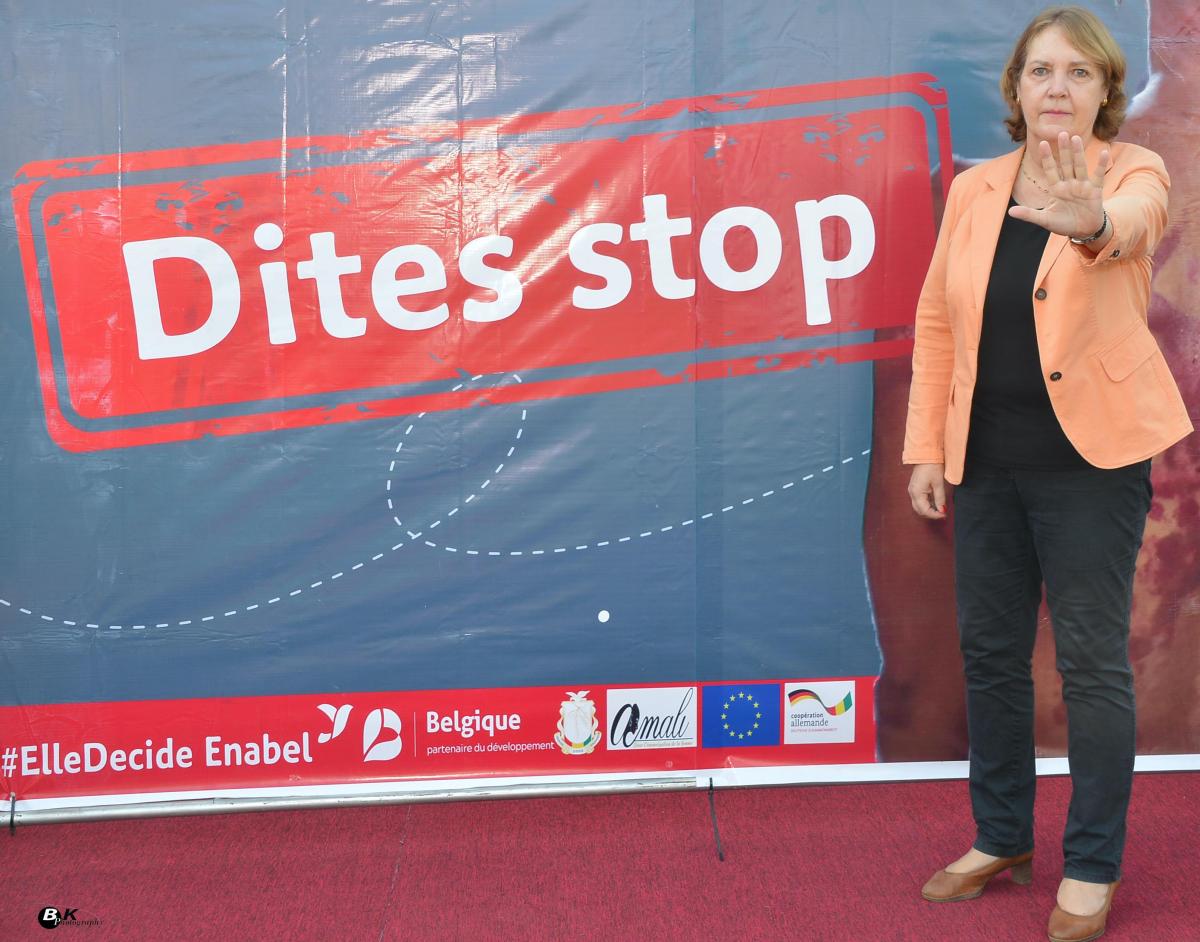
Guinée: Le projet She Decides se mobilise pour les 16 jours d'activisme!
Mamadou Moustapha BALDE | 15/12/2021
Près d’une femme sur trois âgée de 15 ans et plus a subi, au moins une fois dans sa vie, des violences physiques ou sexuelles.Chaque année, les #16joursdactivisme représentent une occasion de mobiliser divers moyens et acteurs pour éliminer ces violences faites aux femmes. Avec ses partenaires, notre projet #SheDecides a organisé plusieurs activités de mobilisation sociale et de communication et de sensibilisation.Une campagne d’affichage, notamment sur des bus, a été déployée. Un concours vidéo, axé sur la lutte contre les VBG et l’accès aux droits sexuels et reproductifs, a été organisé et les prix officiellement remis.Ces vidéos alimenteront notamment l’application mobile #Kouyé, que nous développons avec la GIZ, pour, entre autres, promouvoir la Santé de la Reproduction.La campagne des 16 jours s’achève. Notre engagement à éliminer les violences faites aux femmes, lui, demeure au quotidien.
-
Burkina Faso: Réflexions sur une meilleure protection des victimes et des témoins
Kimsegninga SAVADOGO | 15/12/2021
Enabel, à travers le Projet d’appui au renforcement de la justice pour lutter contre l’impunité (PARJI) apporte sa contribution à la réflexion sur la protection des victimes et des témoins.L’Organisation Internationale de Droit du Développement (IDLO), en collaboration avec le Ministère de la Justice, des Droits Humains et de la Promotion Civique, ont organisé un atelier de réflexion sur les mécanismes d’assistance et de protection des victimes et témoins au Burkina Faso. L’atelier s’est déroulé dans la ville de Koudougou, du 7 au 9 décembre 2021. L’atelier avait pour objectif principal de contribuer à l’amélioration de l’assistance et de la protection des victimes et témoins au Burkina Faso. C’est au regard de l’importance de la thématique que Madame Victoria OUEDRAOGO / KIBORA, Ministre de la Justice, des Droits Humains et de la Promotion Civique, Garde des Sceaux, a bien voulu présider elle-même la cérémonie d’ouverture de l’atelier. A ses côtés, il y avait Monsieur Yoann THINES, Intervention Manager du PARJI, représentant Enabel et Monsieur Patrick NDIKUMANA, Program Lead – Burkina Faso / Programme Sahelde IDLO. Monsieur Idrissa Passekba OUEDRAOGO, représentant du Directeur de l’Accès à la Justice et de l’Aide aux Victimes (DAJAV) et Monsieur Kounkinè Augustin SOME, modérateur des travaux de l’atelier ont également accompagné Madame la Garde des Sceaux lors de cette cérémonie d’ouverture. Ont participé à ce cadre de réflexion, environ une quarantaine (40) de personnes, représentant la Chancellerie, les juridictions et d’autres structures associatives, des ressorts des Cours d’appel de Ouagadougou et de Fada N’gourma. De la nécessité pour Enabel d’accompagner une telle initiative C’est à travers son Projet d’appui au renforcement de la justice pour lutter contre l’impunité (PARJI) financé par l’Union européenne qu’Enabel accompagne cet atelier de réflexion. Selon Monsieur Yoann THINES, Intervention Manager du PARJI, aucune initiative ne peut prétendre lutter contre l’impunité sans placer au cœur de ses préoccupations le sort des victimes et des témoins en matière pénale. C’est pourquoi, il a tenu à souligner à la garde des sceaux qu’Enabel n’a « pas hésité une seconde pour répondre favorablement aux amis de IDLO et à [la] Direction de l’Accès à la Justice et de l’Aide aux Victimes afin de soutenir cette initiative (…).la protection, l’assistance et l’indemnisation des victimes et des témoins est une question complexe. Elle nécessite une approche concertée et multidisciplinaire (…). Il existe des pistes de solution à travers notamment les formes de justice restauratrice, de modalités d’indemnisation, de réparations adaptées aux besoins des victimes (…) ». Le contenu des travaux de réflexion et d’échanges Durant trois (03) jours, les participants ont pu bénéficier de communications de très belle facture. Les modules étaient riches et diversifiés mais tous visaient à permettre aux participants de mieux cerner la problématique de l’assistance et de la protection des victimes et témoins afin de susciter des recommandations fortes et pertinentes. Au titre des thématiques abordées on peut citer : les aspects définitionnels des notions de « Victimes » et de « Témoins » ;l’état des lieux des besoins d’assistance et des mécanismes de protection des victimes et témoins au Burkina Faso ;le rôle et la responsabilité des acteurs de l’assistance et de la protection des victimes et témoins ;les défis de la protection des victimes et témoins d’actes de terrorisme et de criminalité organisée ;la prise en charge psycho-sociale des victimes et des témoins.Aussi, des travaux de groupe ont permis aux participants de relever les difficultés qui ne permettent pas une prise en compte adéquate de l’assistance et de la protection des victimes et témoins et de faire des suggestions et recommandations pour les surmonter. Des perspectives et des recommandations Le 09 décembre 2021, dernier jour des travaux, les participants ont formulé des recommandations à l’endroit des autorités gouvernementales, des partenaires techniques et financiers et des acteurs de la justice. Ces recommandations visent entre autres à : Elaborer et adopter une loi spéciale pour la protection des victimes et des témoins en s’inspirant du projet de loi type de l’ONUDC ;Mettre en place un mécanisme de prise en charge des frais de transport, d’hébergement et de restauration des victimes et témoins ;Sensibiliser et former les acteurs de la prise en charge des victimes et témoins ;Renforcer les mécanismes de prise en charge psycho-sociale et sanitaires des victimes et des témoins.Ces recommandations ont pour but principal de contribuer à l’amélioration de l’assistance et de la protection des victimes et témoins au Burkina Faso. Geoffroy ZONGO – Communication Officer
-
Burkina Faso: Enabel soutient le Fonds d’Assistance Judiciaire
Kimsegninga SAVADOGO | 14/12/2021
La Commission d’Assistance Judiciaire (CAJ) du Tribunal de Grande Instance (TGI) de Koudougou a reçu un lot de matériel informatique et de fournitures de bureau ce lundi 6 décembre 2021. C’est en présence du Directeur général du Fonds d’Assistance Judiciaire (FAJ), Monsieur Ilassa PORGO, de la Présidente du TGI de Koudougou Madame Wendmanagdé Colette SAWADOGO et du 1er substitut du Procureur du Faso près le TGI de Koudougou, Monsieur Boureima SAWADOGO, que le Président de la Commission d’Assistance Judiciaire (CAJ) du TGI de Koudougou, Monsieur Soumaïla OUEDRAOGO a reçu un lot de matériel informatique et bureautique. Ce matériel a été reçu des mains de Monsieur Yoann THINES, Intervention Manager du Projet d’appui au renforcement de la justice pour lutter contre l’impunité (PARJI). Un projet financé par l’Union européenne et mis en œuvre par l’Agence belge de développement, Enabel. La cérémonie de réception s’est tenue ce lundi 06 décembre 2021 dans les locaux du TGI de Koudougou. A travers ce geste, Enabel entend apporter sa contribution pour un meilleur fonctionnement de la CAJ de Koudougou et permettre ainsi un meilleur accès à la justice pour les justiciables. Rappelons que la CAJ examine les demandes d’assistance judiciaire qui permet aux justiciables, les plus nécessiteux, de bénéficier d’une prise en charge des frais de justice par l’Etat. A ce propos, la faible capacité opérationnelle des Commissions d’Assistance Judiciaire influence négativement le nombre de personnes devant en bénéficier, d’où l’intérêt de renforcer leurs capacités afin d’améliorer l’accessibilité de la justice. La composition du matériel offert Le lot de matériel offert est composé essentiellement de :Un Photocopieur multifonctions, Laser, Couleur;Un Ordinateur portable : Core i5, stockage : 500 G et 8 G Ram ;Deux (02) onduleurs ;Un disque dur externe;Des consommables bureautiques.Le coût total du matériel offert est estimé à 3.5 millions de F CFA, soit 5400 euros. Pas une première pour Enabel Dans le cadre de ses activités, le projet PARJI a déjà offert ce type de matériel aux TGI de Ouaga 1 et de Ziniaré d’une valeur de 7 millions de F CFA, soit 10’800 euros, le 30 novembre 2021. Tous ces équipements offerts par Enabel à travers le PARJI ont pour principal objectif l’appui au Fonds d’Assistance Judiciaire (FAJ) qui en a fait la demande au profit de certaines Commissions d’Assistance Judiciaire des différents TGI du ressort de la Cour d’Appel de Ouagadougou. D’autres initiatives du genre entrant dans le cadre de la mise en œuvre du PARJI seront réalisées au cours de l’année 2022, notamment l’appui stratégique au FAJ, en vue de contribuer à un meilleur fonctionnement de la justice pour lutter contre le sentiment d’impunité que peuvent ressentir de nombreux justiciables dans le pays. Geoffroy ZONGO - Communication Officer
-

Removing education barriers with sustainable infrastructure in Uganda
Dorothy KYAMAZIMA | 13/12/2021
Education infrastructure such as buildings, classrooms, libraries and equipment are crucial elements of learning environments in schools. Infrastructure plays a very big role in the teaching and learning process as it determines the extent of accessibility and creativity in the teaching and learning process. Together with the Ministry of Education and Sports in Uganda, we are working to improve secondary teacher education by rehabilitating, expanding and equipping college facilities to include: · Safe learning spaces for both students and teachers · Digital infrastructure and · Climate responsive infrastructure Watch the video to find out more about our infrastructure component.
-

Projet PASPort au Bénin : Après 28 mois d’exécution, près de 60% du budget déjà engagé!
Reece-hermine ADANWENON | 13/12/2021
Améliorer la compétitivité du secteur portuaire à travers l’amélioration du climat des affaires et le renforcement de la performance des acteurs (para) portuaires; c’est l’objectif visé par le Projet d’Appui au développement du secteur para (portuaire) ''PASPort''. Exécuté par l’Agence belge de développement ''Enabel'' sur financement de la Belgique, le projet après 2 années de mise en œuvre a été passé en revue par des évaluateurs externes. Au terme de leur mission d’évaluation, l’équipe des consultants composée des sieurs Hubert Cathala (Chef d’équipe) , Olivier Crouzier et Siddick Moubachirou Experts portuaires ont partagé avec l’ensemble des acteurs et bénéficiaires du projet les résultats issus de cette évaluation. C’était à la salle de réunion du Port Autonome de Cotonou le lundi 22 Novembre 2021. De cette restitution, il ressort que le projet PASPort en 28 mois d’exécution a développé une approche systémique d’appui aux acteurs en amont et en aval de la chaîne logistique ayant le Port Autonome de Cotonou (PAC) en son cœur en identifiant à ce stade 123 actions particulières au profit d’environ 25 services, directions, agences, ministères. Cet effort intense a permis à la fois de réfléchir avec l’ensemble des acteurs pour décider des actions prioritaires à engager afin de les aider à mieux assumer leur mandat et faire face à des problématiques spécifiques, mais aussi a été l’occasion pour l’équipe du projet de saisir des opportunités de collaboration dans plusieurs domaines qui n’avaient pas pu être identifiés lors de l’élaboration de la stratégie initiale du projet. C’est ainsi que ces 28 premiers mois auront permis d’affecter globalement près de 93% du budget dédié spécifiquement aux actions. Le projet PASPort va consacrer environ 70% de son budget à des actions de formation ou de consultances, et 30% environ à des actions d’équipement, ou d’aménagement au profit des structures partenaires. Au terme de ces 28 mois d’activité, environ 35 % de son budget global de 10 millions d’euros a été décaissé, et ce grâce à l’engagement notamment de 74 actions sur les 123 identifiées. C’est au niveau du PAC que l’équipe d’évaluation a pu constater les premiers effets de l’ensemble des actions engagées. En effet le taux d’exécution du budget du résultat 2 dédié au PAC est de près de 53% et pratiquement 90% du budget est déjà engagé, c’est-à-dire déjà signé et en cours, à mi-parcours du projet. Selon les évaluateurs, les représentants des parties prenantes rencontrés au cours des 25 réunions d’échanges organisées lors de la semaine d’évaluation, ont unanimement apprécié les méthodes de suivi et d’exécution des différents chantiers en cours dans le projet. Les évaluateurs avaient pu, à travers la préparation réalisée par l’équipe projet, bénéficier de la remise d’un rapport d’auto évaluation leur donnant une mesure à mi-parcours des indicateurs prévus et une estimation de l’atteignabilité des indicateurs à terme du projet. Le projet PASPort est en train d’aider le Ministère des Infrastructures et Transports (MIT) à revoir la stratégie nationale de la Protection, Sécurité et Sûreté Maritime, la validation et l’appropriation du Plan SAR (Search And Rescue) Maritime du Bénin, la rédaction de la nouvelle loi sur le transport routier, l’actualisation de l’ancien décret sur le transport terrestre et l’appui à l’élaboration de tous ses décrets, l’élaboration de l’atlas de vulnérabilité des côtes à la pollution par les hydrocarbures. Par ailleurs, afin que soit prise en compte la problématique environnementale au niveau portuaire, le projet PASPort a aussi accompagné sur plus d’une année le Ministère en charge du cadre de vie et développement durable (MCVDD) à la révision complète de la loi sur l’environnement et l’appui à l’élaboration ou l’actualisation de la totalité des décrets de cette loi. Toujours au titre de ce résultat 1, la collaboration en cours avec l’Agence Nationale de transport terrestre (ANaTT) concernant les modalités de gestion du fret de marchandises transitant par le Bénin et la révision du contenu et des modalités du permis de conduire poids lourds font notamment partie des actions très attendues pour les deux prochaines années d’exécution du projet PASPort. Pour ce qui concerne le résultat 2 du projet dédié entièrement au Port Autonome de Cotonou, il est très important de considérer que près de 85 % du budget déjà décaissé a été orienté vers des actions de formation ou des études de faisabilité ou d’expertises spécifiques. Parmi les actions majeures, à la fois en termes de budget et en termes de visibilité fondamentale pour le PAC, se situe l’action dédiée au recyclage complet de tous les équipages des remorqueurs et pilotes (au départ 25 agents) et des pilotes de navires (au départ 10 agents). La capacité d’un Port à assumer cette fonction de base est la première des étapes pour un Port qui veut rester attractif, et au-delà qui souhaite accueillir des navires de plus grande taille. Bien entendu, l’effort de formation réalisé par le projet PASPort au cours des 28 premiers mois a ciblé la quasi-totalité des directions et services du PAC, avec notamment un gros effort dans l’appui à la digitalisation (avec un investissement en matériel et logiciel par ailleurs), mais aussi au niveau de la direction des affaires juridiques et du contentieux, du service de génie mécanique et électrique, du service de l’audit interne, de la capitainerie. Ces formations avaient pour objet de renforcer donc aussi bien la maîtrise du cœur de métier au niveau du personnel tout comme les fonctions supports et les domaines transversaux. En ce qui concerne le troisième résultat relatif à l’amélioration de la mise en œuvre de la politique environnementale pour les acteurs portuaires, les évaluateurs ont pu constater l’engagement de plusieurs actions à trois niveaux différents : - Des actions au profit du PAC, don’t notamment l’engagement d’études sur la pollution des sédiments dans le bassin portuaire, l’initiation d’une cartographie de la pollution dans l’enceinte portuaire, l’acquisition de matériel de laboratoire pour la Plateforme Portuaire de Surveillance Environnementale (PPSE) et la signature d’une convention de subsides entre Enabel et l’Institut de Recherche pour le Développement (IRD) en vue de suivre les espèces envahissantes ; - Des actions au profit des autres acteurs portuaires, et ce à travers la prochaine initiation d’une collaboration avec notamment le Laboratoire des Sciences et Techniques de l’Eau et de l’Environnement relevant de l’Université d’Abomey-Calavi (UAC) et le PAC sur plusieurs thèmes liés à la pollution dans le secteur portuaire, y compris les campagnes d’analyses de l’eau ; - Des actions au profit des acteurs étatiques en charge du contrôle et de la régulation du volet environnemental dans le secteur portuaire, avec trois principaux partenaires don’t la brigade spéciale forestière du Port, le centre de quarantaine et de fumigation végétale du Port, la brigade canine relevant de la Direction Générale de la Police Républicaine (DGPR) en vue du contrôle des trafics d’ivoire et d’écailles de pangolins, en collaboration avec l’ONG internationale IFAW. Du point de vue tant de la pertinence que de l'efficience et l’efficacité du projet PASPort, les évaluateurs ont fait part de leur appréciation positive sur la base des échanges et des données collectées. Plus spécifiquement ils ont pu observer et apprécier l’approche d’Enabel concernant le transfert de compétences, basée sur le concept de parcours d’acquisition des compétences caractérisé par ces trois phases de diagnostic, de formation, et d’accompagnement sur place post formation. Cette approche a permis une véritable professionnalisation du personnel. Ils ont aussi apprécié la démarche d’élaboration participative des termes de références des requêtes d’appui, permettant de décomposer les problématiques à traiter à partir d’exemples concrets et d’approches processus. Ils ont enfin aussi constaté, au niveau des actions réalisées pour le PAC, le souci d’élaborer d’un commun accord un ensemble d’indicateurs et de critères d’évaluation permettant à terme d’apprécier les effets et les impacts de l’investissement en formation. Un point très significatif a été également noté, celui de la bonne collaboration entre les deux entités publiques belges à savoir Enabel et le Port d’Anvers (PAI) dans la mise en œuvre de ce projet, qui ont chacun su et pu travailler de manière complémentaire sur les divers segments de la chaîne logistique, ce qui constitue certainement pour la Belgique une expérience très réussie qui pourra être répliquée ailleurs et poursuivie bien entendu au Bénin. Les principales Leçons apprises selon les évaluateurs : * L’activité d’Enabel est maintenant établie à un bon niveau et produit un ensemble de résultats impressionnants. * Le nombre des actions correspondant aux sous résultats est très élevé et il est souhaitable de les réduire lorsque l’atteinte de ces derniers dans les délais impartis devient critique. * La recherche de partenaires est généralement fructueuse mais il convient de les tester par la suite dans le temps * Les méthodes et la manière de faire d’Enabel sont validées par les bénéficiaires qui apprécient la modestie, l’expertise et la qualité du travail de l’équipe d’Enabel ; * Les bénéfices doivent être appréciés par rapport aux résultats identifiés mais également par rapport aux changements intrinsèques produits et aux facteurs synergétiques.
-
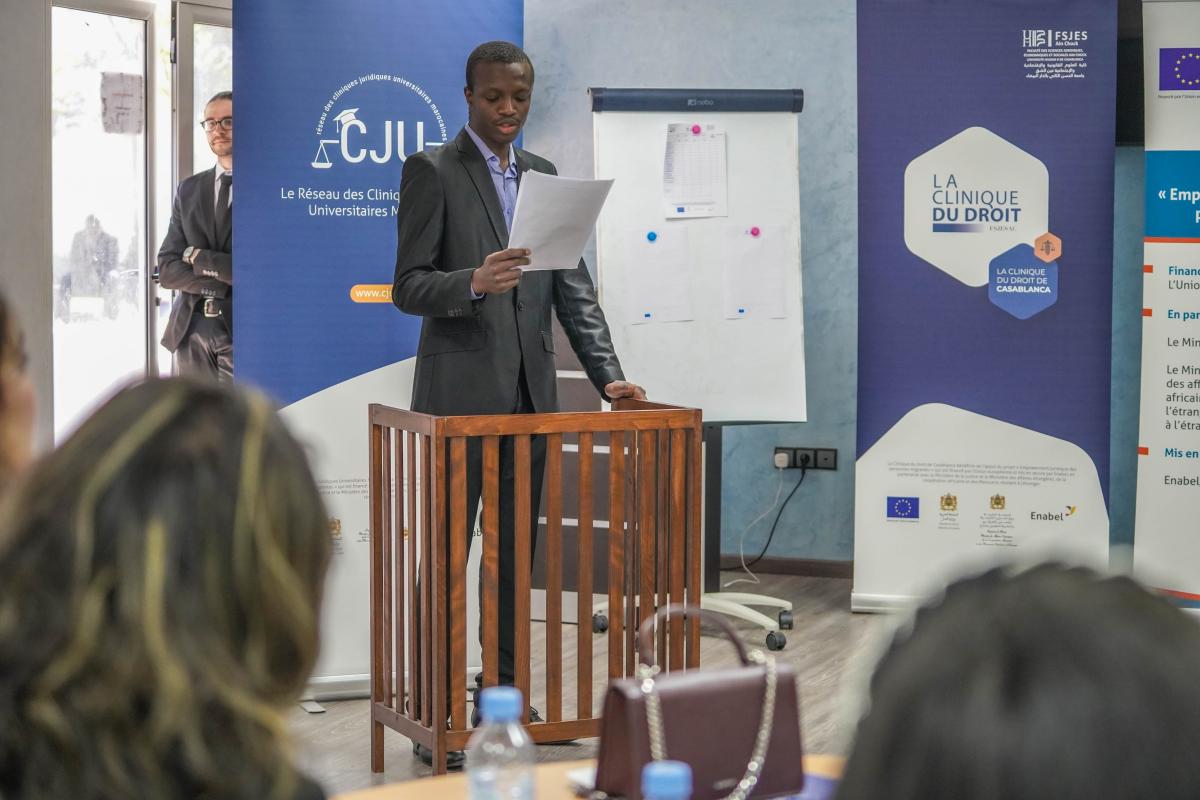
Maroc: La clinique juridique comme structure universitaire d’innovation pédagogique et sociale
Bilal ALJOUHARI | 13/12/2021
A l’occasion de la semaine du migrant organisée par le Ministère des Affaires étrangères, de la Coopération africaine et des Marocains résidents à l’étranger, du 13 au 18 décembre 2021, la Clinique juridique de droit de la Faculté des sciences juridiques économiques et sociales de l’Université Hassan II de Casablanca organise des journées portes ouvertes, du 13 au 16 décembre 2021, sous le thème : "La clinique juridique comme une structure universitaire d’innovation pédagogique et sociale". Cette semaine d’activité est l’occasion pour la Clinique du droit d’inaugurer officiellement son siège et de présenter le bilan de son travail actuel en matière d’appui à la recherche et à la production scientifique sur le droit de la migration et l’asile mais également en matière de remise d’avis juridique auprès de la population migrante. De plus, la clinique organisera une série d’ateliers de réflexion, de tables rondes, de conférences et de sessions de formations qui permettront aux nouveaux étudiants membres de la clinique juridique de bénéficier de l’expertise de différents acteurs travaillant sur la thématique migratoire, notamment dans la région Casablanca – Settat. Cet évènement s’inscrit dans le cadre de la collaboration entre la Clinique de droit etc le projet « Empowerment juridique des personnes migrantes », financé par l’Union européenne et mis en œuvre par Enabel, en partenariat avec le Ministère de la Justice et le Ministère des Affaires étrangères, de la Coopération africaine et des Marocains résidant à l’étranger. Cette collaboration vise à renforcer d’un côté l’enseignement et la recherche du droit d’asile et de la migration et de l’autre côté la pratique clinique du droit des étrangers. À noter que les journées portées démarrent par la finale du concours de plaidoyer organisé dans le cadre des activités du Réseau marocain des cliniques universitaires. Le réseau réunit les cliniques juridiques des Facultés des sciences juridiques, économiques et sociales des universités Hassan II de Casablanca, Mohamed I d’Oujda, Abelmalek Saâdi de Tanger et Mohamed V de Rabat. Le réseau contribue au partage des connaissances et expertises de chacune des cliniques juridiques membres et il vise à promouvoir l’enseignement de la pratique clinique et du droit de la migration et de l’asile au Maroc.
-
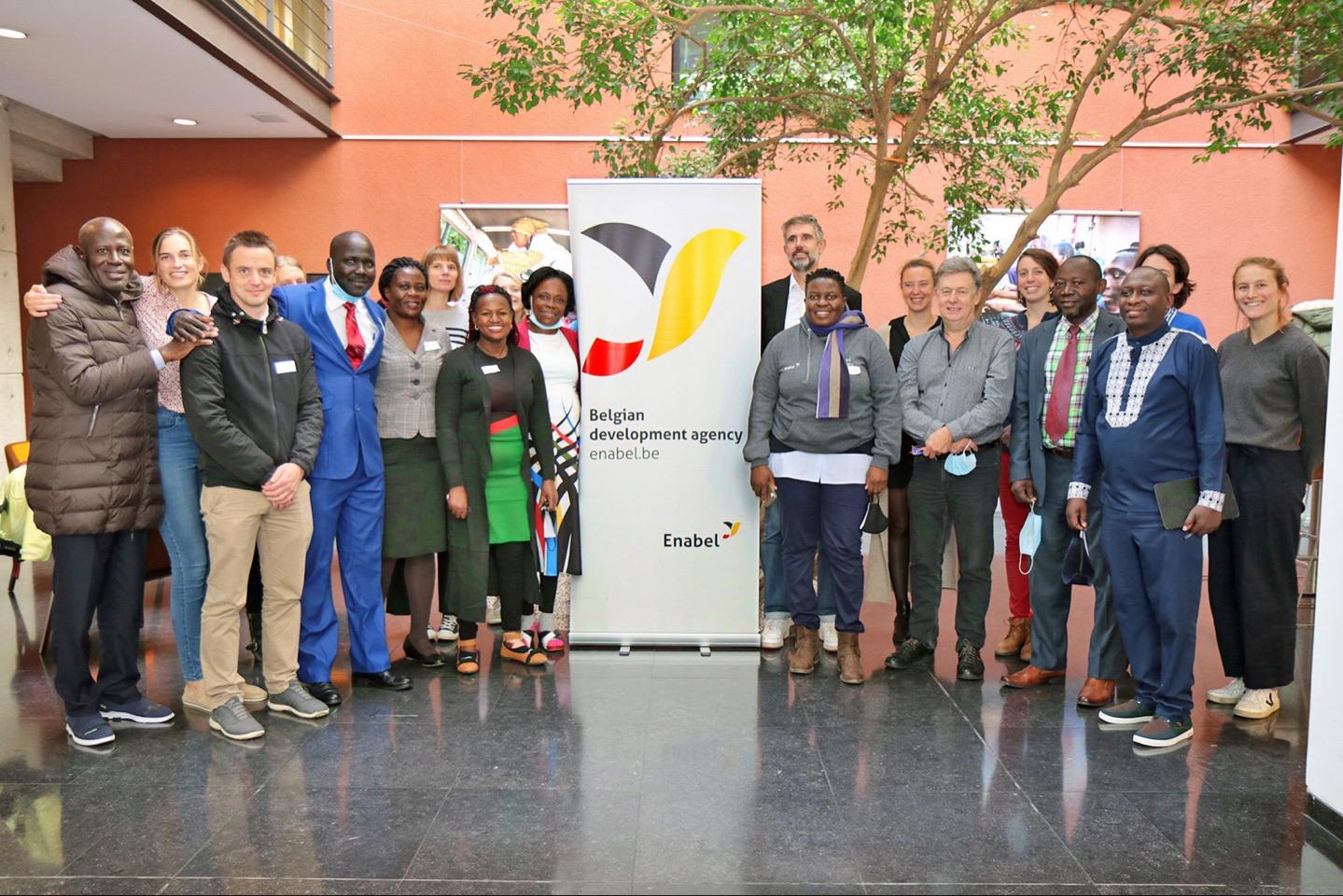
NTC lecturers from Uganda visit Belgium during an exchange programme
Peace NERIMA | 13/12/2021
In October and November 2021, Annoncer La Couleur and Kruit - the French and Flemish-speaking global citizenship education programmes from Enabel in Belgium - and Enabel’s Teacher Training Education project (TTE) organized two intercultural knowledge sharing exchange visits between lecturers from the NTCs in Uganda and teacher trainers in Belgium. The purpose of this year’s Annoncer La Couleur visit was to improve intercultural competences of both Belgian and Ugandan lecturers; strengthen relations between Enabel in Uganda and Belgian partners; anchor Global Citizenship Education in the NTCs; and, share the good practices related to Technology Enhanced Learning and Active Teaching and Learning.Likewise, for the Kruit exchange visit, the aim was to share how colonial history is addressed in both the Flemish and Ugandan education systems; reflect on lessons learnt from colonial history in terms of decolonisation and work collectively on interesting topics about colonial history.Annoncer La Couleur exchange visit for GTM lecturers The Annoncer La Couleur was a return of last year’s visit of teacher trainers from Belgium to the National Teachers’ Colleges in Uganda in March 2020. It was a weeklong event filled with activities directly linked to pedagogy in the National Teachers Colleges such a; classroom observations, an introduction to the Belgium teacher education system, understanding the Global Citizenship Education program, and understanding Belgian culture through site visits.While in Belgium, the team of General Teaching Methods’ lecturers kicked off their visit at Henallux in Malonne, a teacher training institution. While there, they discovered flexible learning spaces, learnt about the Henallux library, observed a Physical Education lesson and shared good practices on ICT in teaching and learning. They were then hosted at the Enabel Headquarters and introduced to workshops on Global Citizenship Education, and an insightful framework for ethical global pedagogy, called ‘HEADS UP’. Later on, the team was welcomed at Helha college and La Maison des Phenix secondary school where they came across various ICT tools used for teaching and learning and observed English, Music, Geography and History lessons. To conclude this visit, the GTM lecturers toured the great city of Gent and explored historic architecture going as far back as the 1700s. They also had an opportunity to visit Krook library, a wonderful space for interaction, research and knowledge building.Kruit exchange visit for history teachersThe Kruit exchange visit was focused on bringing history teacher trainers together to share knowledge on how the colonial past is addressed in history education in both the Ugandan and Belgian education contexts. The key activities of this exchange included field visits and workshops particularly focused on teaching colonial history in contemporary times with a specific emphasis on adopting multiple perspectives on decolonisation.During the visit, the team spent some time at Enabel Headquarters and participated in a workshop on Ethical Global Issues pedagogy from which they gained skills on how to think through and apply critical literacy in teaching. They were further challenged to use the HEADS UP tool during a session on teaching about history in a post-colonial context. A very sensitive but interesting topic on teaching about slavery in a post-colonial context and its impact was also explored at the workshop. As part of this session, the team was presented with research findings from the shared colonial past in Belgian and Congolese school text books and their evolving representations by an expert team in Global Citizenship Education at Enabel HQ.Towards the end of the trip, the NTC history lecturers interacted with Belgian teacher trainers connected to the KUL (Catholic University of Leuven) and BimSem secondary school in Mechelen. While at these institutions, they were introduced to various colonial history teaching practices through lesson observations and discussions. The two teams also participated in a brainstorming session on lesson packages to develop together on a selected history topic applicable in both contexts and discussed the criteria for a manual on colonial history education for which they will co-create in March 2022 when the Kruit team visits Uganda.The trip was topped with an exciting guided tour to the Royal Museum of Central Africa in Tervuren- formerly known as the Belgian colonial museum for Congo used for propaganda to justify King Leopold II’s colonial rule over Congo.All in all, the exchange visits were exciting knowledge-sharing experiences for the teams from Uganda and Belgium for which they hope to share with the rest of the NTC Community. Visit the sites provided for more on the exchange visits:Annoncer La Couleur: https://bit.ly/3nBBEgXKruit: https://bit.ly/3xm7rH1To access last year’s exchange visit: https://bit.ly/3dHX9Iq
-
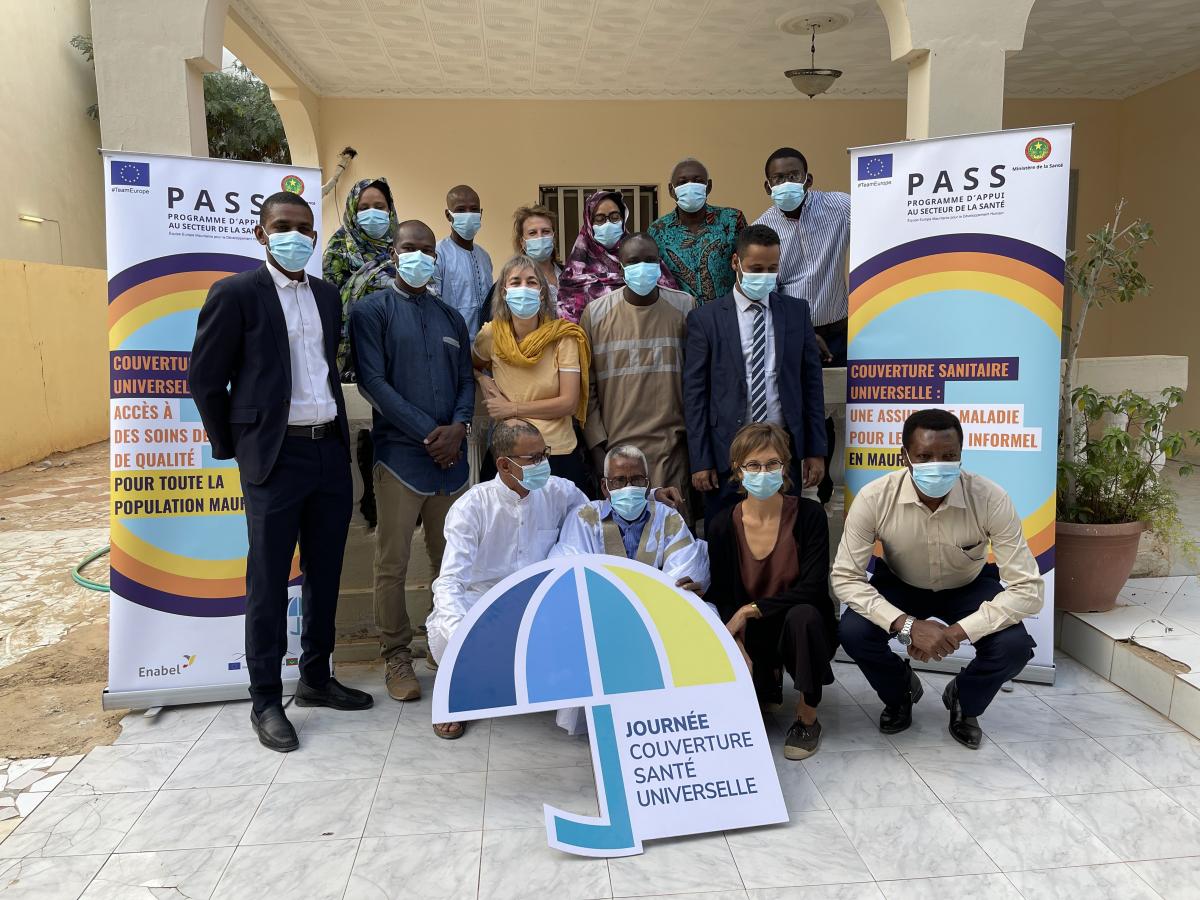
Enabel Mauritanie célèbre la journée internationale pour la couverture sanitaire universelle
Aminata KANE | 13/12/2021
L’atteinte de la Couverture Sanitaire Universelle à l’horizon 2030 en Mauritanie constitue l’un des objectifs en ligne avec la Politique Nationale de Santé du pays que poursuit l’Union européenne pour améliorer et rendre plus équitable l’accès aux soins de santé de qualité pour toute la population mauritanienne en particulier la plus vulnérable. A ce titre, en partenariat avec le Gouvernement mauritanien, l’Union européenne et ses États membres (Équipe Europe) se mobilisent pour illustrer l’engagement politique de la Mauritanie par rapport à l’objectif CSU 2030.Ainsi cette année, au travers du Programme d’Appui au Secteur de la Santé (PASS) mis en œuvre par l’Agence belge de développement, Enabel et par une subvention allouée au Ministère de la Santé, l’Union européenne marque la journée du 12 décembre 2021 pour accompagner l’engagement politique de la Mauritanie dans sa volonté affirmée d’atteindre la Couverture Santé Universelle d’ici 2030.
-

Maroc : L’équipe du projet Amuddu se réunit pour produire un guide au profit des organisations de la société civile œuvrant dans l’intégration économi
Clara HUYGHE | 10/12/2021
Le projet Amuddu a organisé un atelier de concertation avec ses partenaires institutionnels et les associations de la société civile afin de formaliser leur savoir acquis en matière d’intégration économique des personnes migrantes et réfugiées pour le mettre à disposition d’autres acteurs. Cet atelier a été mené dans une démarche de valorisation des connaissances et de partage des meilleures pratiques testées et approuvées par l’intervention. Les échanges captés lors des travaux de groupe à travers des matrices de capture construites avec les partenaires en amont ont permis d’enrichir un guide pour le renforcement de partenariat entre les organisations de la société civile et les institutions publiques.En effet, les parties prenantes ont travaillé en différents groupes en fonction de leur domaine d’expertise, à savoir la formation professionnelle, l’accompagnement auto-emploi, le mentorat et la sensibilisation du secteur privé. Suite à ces échanges, les mécanismes de coordination entre les organisations de la société civile et les institutions publiques ont pu être identifiés ainsi que les étapes de collaboration entre elles, les bonnes pratiques, les enseignements tirés, les outils utilisés et finalement les pistes d’amélioration.Il a été également identifié que la typologie des partenariats et collaborations établit dans le cadre du projet répond à deux objectifs, soit un besoin de complémentarité, soit à un besoin d’innovation. Une nouvelle étape dans le processus de capitalisation de l’intervention qui se voulait inclusive, collaborative, interactive et novatrice pour nos partenaires.
-
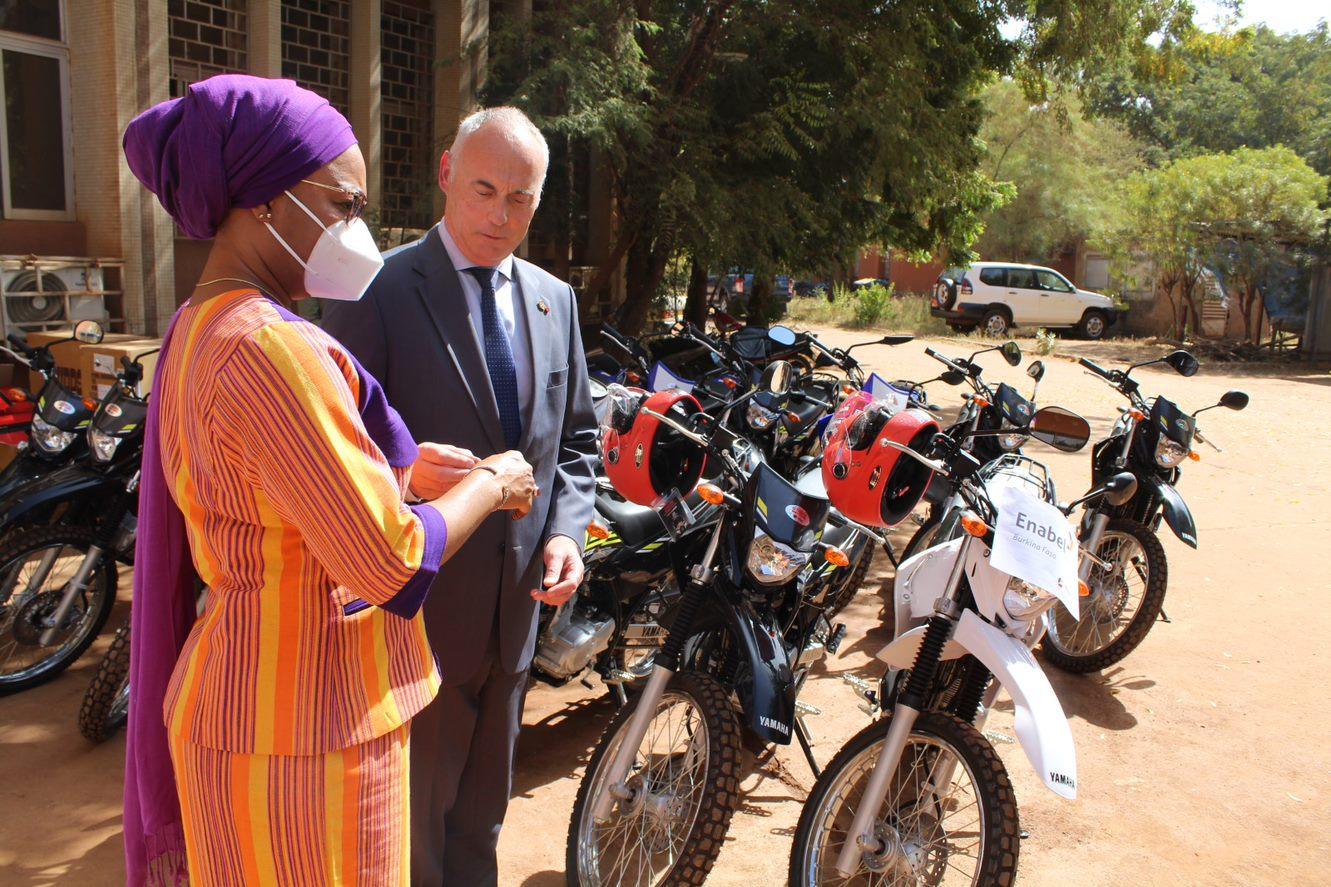
Burkina Faso: Don de matériel électronique et roulant pour renforcer la lutte contre les violences basées sur le genre
Kimsegninga SAVADOGO | 09/12/2021
Afin de renforcer la lutte contre les violences basées sur le genre (VBG), Enabel au Burkina Faso a offert mardi 7 décembre 2021, à Ouagadougou, du matériel électronique et roulant d’une valeur de 66 millions de francs CFA au Ministère de la Femme, de la solidarité nationale, de la famille et de l’action humanitaire, pour le compte de la région du Centre-Est du Burkina Faso. Le matériel réceptionné officiellement par la ministre en charge de la Femme, Mme Hélène Marie Laurence ILBOUDO/MARSHALL se compose de : quatorze (14) motos à deux roues ;vingt-deux (22) ordinateurs de bureau ;quinze (15) onduleurs;cinq (05) imprimantes ;douze (12) ordinateurs portables ;quatre (04) vidéoprojecteurs ;douze (12) rallonges ;quatre (04) postes téléviseurs ;huit (08) climatiseurs. La remise de cet important matériel a été effectuée par l’ambassadeur du Royaume de Belgique au Burkina Faso SEM. Jean-Jacques QUAIRIAT qui avait à ses côtés le Représentant Résident d’Enabel au Burkina Faso M. Olivier KRINS. Avant la remise symbolique du matériel, l’ambassadeur a rappelé l’engagement d’Enabel à accompagner le ministère en charge de femme pour « renforcer sa capacité dans la gestion des cas de VBG » SEM. Jean-Jacques QUAIRIAT est notamment revenu sur : la dotation aux services sociaux du Centre-Est par #Enabel d’un système de gestion de données ;la réalisation d'infrastructures au niveau des bureaux provinciaux du Kourittenga et du Boulgou permettant d'assurer dans des conditions optimales, un travail de suivi psychosocial tout en garantissant un meilleur accueil aux demandeurs de services, dans le respect des principes directeurs de la prise en charge des VBG. La remise du matériel s’inscrit dans le cadre de la mise en œuvre du projet Santé et droits sexuels et reproductifs (SDSR) d’#Enabel au Burkina Faso. Le matériel remis est destiné aux acteurs étatiques de la prise en charge des VBG dans la région du Centre-Est, et permettra d’améliorer l’action sur le terrain, l’enregistrement et le traitement des données au niveau de cette partie du pays. En effet, dans le cadre de la coopération entre le Burkina Faso et le Royaume de Belgique, #Enabel met en œuvre au Burkina Faso des projets en vue de promouvoir le développement économique et social durable et inclusif au profit des citoyens burkinabè. Parmi ces projets, figure le Projet SDSR qui a pour objectif de renforcer les droits sexuels et reproductifs des femmes et des jeunes filles dans la région du Centre Est. A travers le projet SDSR, Enabel accompagne le Ministère en charge de la femme dans sa mission de prévention et de réponse aux VBG. Cette année par exemple, #Enabel a notamment accompagné le Ministère de la femme dans la réinsertion économique et sociale des survivantes de VBG. Cette réinsertion se traduit entre autres par le renforcement des : mécanismes communautaires (Familles d'accueil et cellules villageoises d'alerte, de prévention et de référencement, référentiels, etc.…) ; actions de la société civile, l’appui aux micro-projets économiques;capacités des agents sociaux impliqués dans la gestion, la réinsertion et le suivi des cas de VBG. L’acquisition et la remise de ce matériel vient à point pour faciliter la mobilité et le travail de terrain des agents sociaux de région du Centre-Est. Selon les résultats d’une étude menée dans la région du Centre Est par des acteurs académiques belges de l’Université de Liège et burkinabè de l’Université Thomas Sankara : 81% des femmes enquêtées ont subi au moins une violence ;72% des femmes sont victimes de violences culturelles ; 51% des femmes sont excisées ;34% d’entre elles ont été mariées avant l’âge de 18 ans ; 16% ont été forcées au mariage ; 22% subissent des violences psychologiques ou morales ; 8% ont été victimes de violences sexuelles.
-
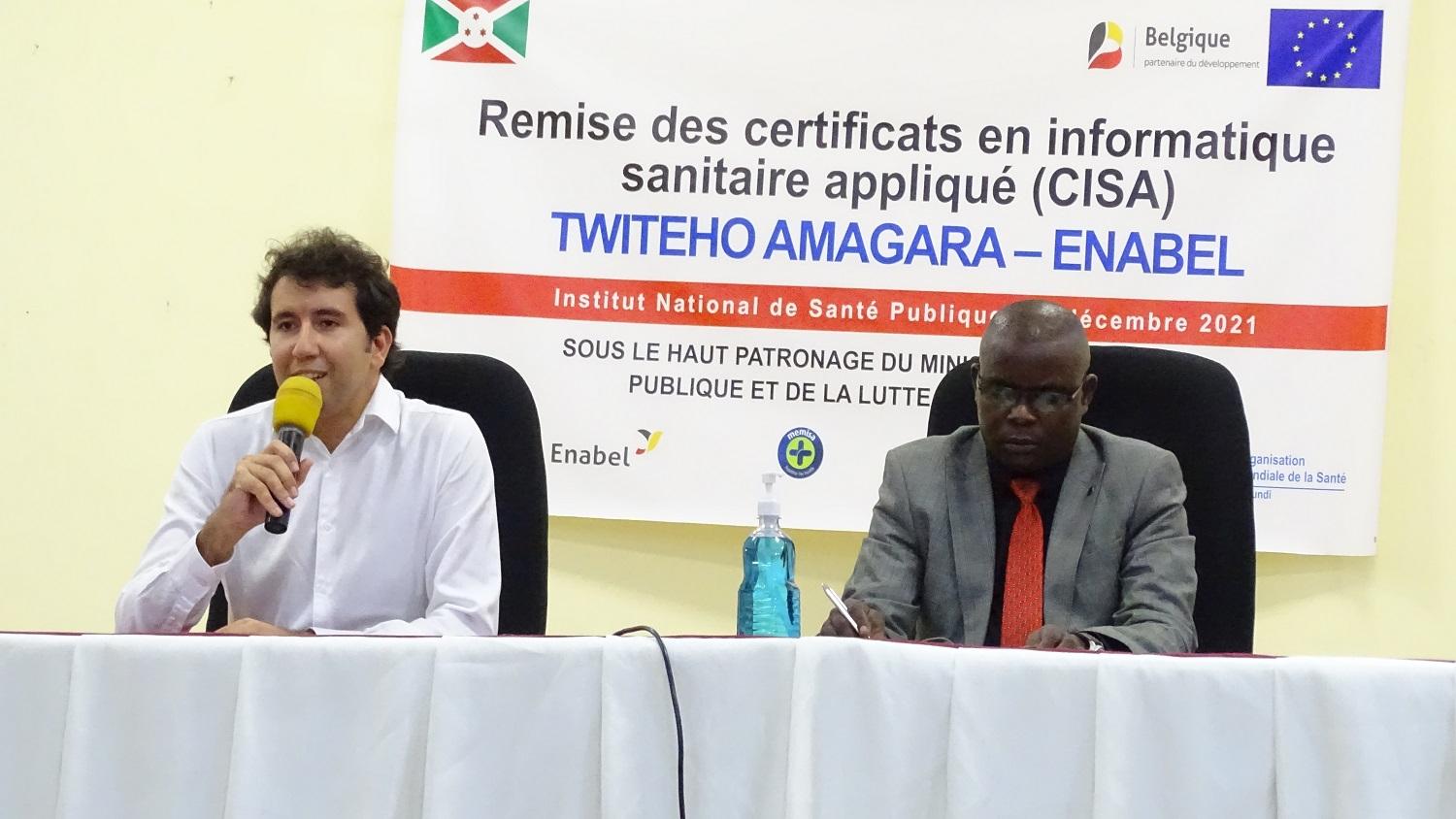
Burundi : Des ressources humaines au service de la digitalisation de la santé
Jean BIRONKWA | 08/12/2021
Elles sont au total 48 personnes, 12 femmes et 36 hommes à être certifiés en Informatique de santé Appliquée. Cette activité réalisée grâce au projet TWITEHO AMAGARA et PAISS 4 s’inscrit dans la droite ligne de la politique du Gouvernement qui est la digitalisation du secteur de la santé au Burundi. Ces lauréats qui ont reçu leurs certificats proviennent du Ministère de la Santé publique et de Lutte contre le Sida (médecins, paramédicaux, informaticiens), d’autres viennent du secteur privé. C’est le résultat du projet TWITEHO AMAGARA & PAISS 4 financés respectivement par la Belgique et l’Union européenne à travers le consortium Enabel afin de garantir à la population un accès à un système de santé avec une qualité des services améliorés ainsi qu’une satisfaction avec les soins reçus. Pour atteindre ce résultat, le projet en partenariat avec l’Institut National de la Santé Publique a mobilisé, pour une période de trois mois, des experts qui ont dispensé treize modules, en présentiel ou à distance, aux membres clés du personnel de la santé déjà bénéficiaires des applications en usage dans le secteur de la santé. Cette formation en Informatique de Santé Appliquée s’est adressée aux utilisateurs des différentes applications courantes implémentées au Burundi comme le (i) DHIS2, (ii) OpenClinic (iii) courriel électronique sécurisé, (iv) aide à la décision clinique (SPT et Ikirezi), (v) gestion de la maintenance (GMAO), et autres. Les différents responsables apprécient cet appui et souhaitent la pérennisation de cette formation Pour le Directeur Général de l’Institut National de la Santé Publique, Dr NYANDWI Joseph, qui a représenté le Ministère de la Santé publique et la Lutte contre le Sida, « Cette formation s’inscrit dans la mise en application de la politique Nationale de la Santé 2016-2025 concernant l’information sanitaire ». Il a rappelé que dans le but de s’approprier cette initiative, il est nécessaire de mettre en place une structure locale propre au Burundi pour assurer la formation aux professionnels de la santé. Il a enfin remercié Enabel et l’Union Européenne pour avoir soutenu cette formation et les a exhortés de continuer à appuyer le deuxième tour CISA 2 afin d’accompagner la mise en place effective d’un Centre d’Excellence pour la Recherche et la Formation en Informatique de Santé au sein de l’INSP. Présent à la cérémonie, le Représentant Résident, Abou El Mahassine FASSI-FIHRI a, quant à lui, indiqué qu’Enabel s’est engagé à accompagner le Ministère de la Santé Publique et de la Lutte contre le Sida dans sa grande vision de digitalisation du secteur de la santé, qui nécessite de grands financements mais aussi des ressources humaines compétentes. Le Représentant Résident a promis de continuer à appuyer ce secteur. Les lauréats de cette formation ont exprimé la joie d’avoir été bénéficiaires de cette initiative et ont suggéré que la formation en informatique de Santé Appliqué soit intégrée dans la formation de la médecine au Burundi.
-

Au Burkina Faso, dons d'équipements aux acteurs du milieu éducatif
Kimsegninga SAVADOGO | 07/12/2021
Enabel à travers l’intervention #Paas-panga, offre 14 ordinateurs et 19 tablettes aux meilleurs enseignant·es et encadreur·ses pédagogiques de la région du Centre Est. Ces lauréats se sont illustré·es par leur fort taux de succès dans leurs écoles en 2020. D’une valeur d’environ 10 millions 400 mille francs CFA, ces équipements qui bénéficient aux acteurs/actrices du monde éducatif leur permettront d’améliorer les conditions de préparation des cours et de conservation des données, gage d’un bon rendement scolaire. C’était lors de la célébration de la 15 ème édition de la « Journée de l’excellence régionale à l’école » tenue ce samedi 04 décembre 2021 à Koupéla dans la région du Centre Est du Burkina Faso. Présidée par le Gouverneur de la région du Centre Est M. Antoine OUEDRAOGO et parrainé par Enabel , cette édition a été célébrée sous le « Excellence scolaire et Sécurité : Facteurs de croissance économique, social et culturel du Burkina Faso ». Cet accompagnement d’Enabel témoigne de son engagement à œuvre aux côtés des partenaires et des collectivités territoriales à améliorer l’accès et la qualité de l’éducation pour le plus grand nombre d’enfants, gage d’un développement local durable dans la région du Centre Est. Au regard du contexte dans lequel se déroulent les activités pédagogiques, cette récompense rend un grand hommage aux braves enseignant-es et encadreur-ses de la région, qui malgré des conditions de travail parfois difficiles exacerbées par la maladie du coronavirus, la crise sécuritaire marquée par les attaques terroristes et la fermeture de plus d’une trentaine d’écoles dans la région, arrivent à réaliser le taux de 100% d’admis·es aux examens organisés au niveau national. « Seul le travail paie »Dans son allocution, M. Lionel TIENTEGA,représentant Enabel et les partenaires, a exhorté tous·tes les acteurs/actrices à incarner les valeurs positives du travail de la fourmi : minutieuse, infatigables et obstinés, car « Seul le travail paie ». Quelques chiffres : Au classement de 2020 des meilleures écoles au niveau national, la région du Centre-Est est arrivée 3ème sur les 13 Régions du Burkina Faso; sur les 10 meilleurs élèves nominés au Certificat d’étude primaire (SEP) et récompensés par le chef de l’état à la présidence du Faso, 4 sont issus de la Région du Centre-Est et enfin ; la région fut première au classement des régions avec 18 écoles ayant réalisée 1OO% avec des effectifs de plus de 50 élèves par classe. Adama GNANOU - Chargé de communication
-
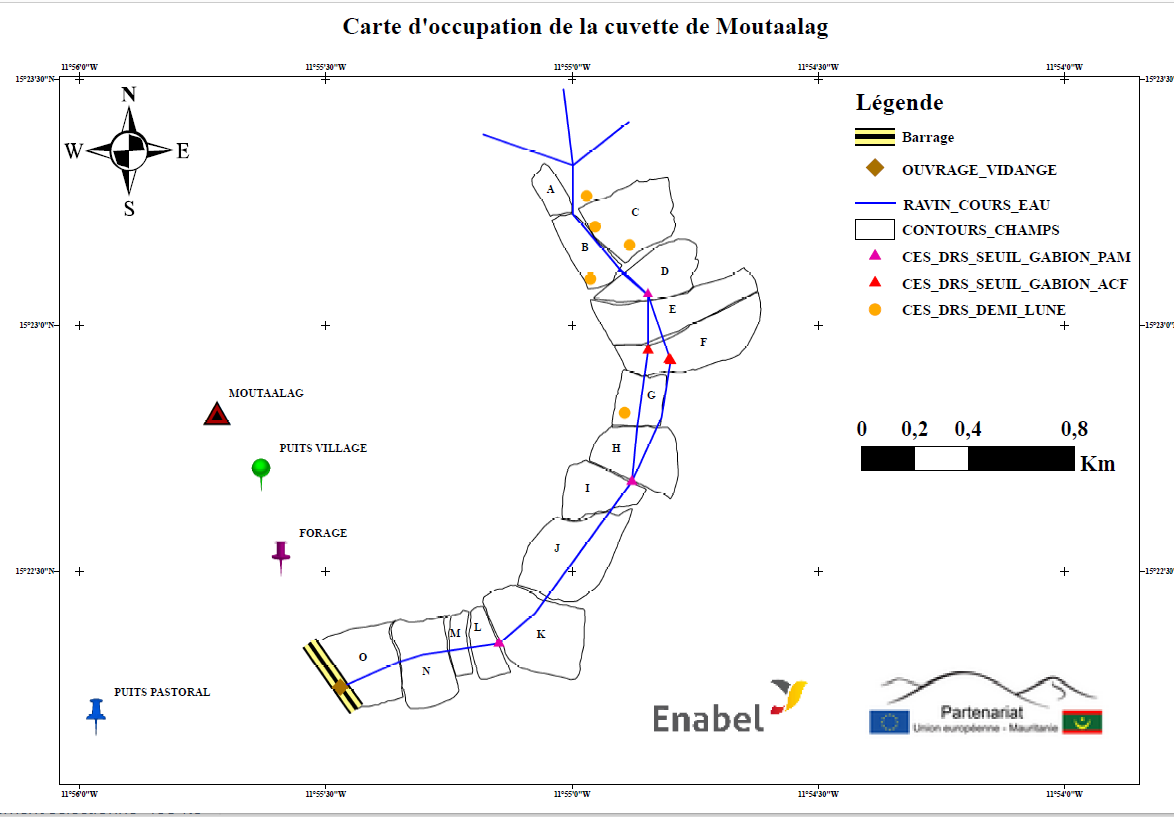
Mauritanie: Atelier d'échanges sur les outils de sécurisation socio-foncière des Infrastructures Rurales et Productives
Aminata KANE | 07/12/2021
Du 16 au 18 octobre 2021 a eu lieu à Kiffa l'atelier d'échanges sur les outils de sécurisation socio-foncière des IRP (Infrastructures Rurales et Productives). Il a été réalisé à la suite d'un d’un état des lieux approfondi des pratiques foncières et d’accompagnement des opérateurs. Il s'est fait sur des sites mis en valeur par des aménagements productifs (aménagements des eaux et des sols, hydraulique agricole et pastorale) dans les 4 Wilayas d’intervention du RIMDIR (Hodh El Gharbi, Hodh El Charghi, Assaba et Guidimakha).La cérémonie d'ouverture a été présidé par le Wali (Gouverneur) de l'Assaba. Les autorités gouvernementales tel que le maire de Kiffa, la représentante du Conseil Régional de la wilaya et les représentants de la Délégation de l'Agriculture et de l'Elevage ont participé à l'atelier au coté de nos représentants de chacune de nos coordinations régionales, ONG partenaires et les gestionnaires d'infrastructures.Le diagnostic permet d’élaborer une proposition d’outils opérationnels de sécurisation socio-foncière à l’usage des techniciens assurant une démarche d’ingénierie sociale sur le terrain. L'atelier contribue à l’élaboration d’une méthodologie consolidée et partagée en matière d’accompagnement socio-foncière, en tant que préalable à la réalisation d’infrastructures rurales productives.Cette démarche d’échange entre acteurs de terrain, incluant les représentants des services de l’Etat (services techniques et administration territoriale) et des représentants des groupes cibles permet de préparer la phase de mise en test / capitalisation prévue dans les 4 régions d’intervention du RIMDIR.Les objectifs de l'atelier sont de :Restituer les leçons capitalisées au cours de l’état des lieux, en matière de pratiques socio-foncières et de méthodologie d’accompagnement des opérateurs d’aménagement.Se concerter afin de consolider une démarche et des outils permettant la sécurisation foncière liée aux infrastructures rurales productives, ainsi que la délégation de gestion des ouvrages publics.Créer un espace d’échange interacteurs autour des travaux du RIMDIR, notamment sur les questions socio foncières et de gestion des infrastructures réalisées et à venir.Proposer et valider la démarche de suivi – capitalisation postérieure à l’atelierL’atelier a permis d’aborder les différentes problématiques foncières et d’analyse les enjeux, afin d’adapter l’accompagnement vers la production d’ententes locales relatives aux modalités d’accès et de gestion des terres, et des autres ressources liées à l’existence des IRP.Résultats atteints sont que:Les leçons capitalisées au cours de l’état des lieux, en matière de pratiques socio-foncières et de méthode d’accompagnement des opérateurs d’aménagement sont restituées.Une démarche concertée et consensuelle d’utilisation des outils permettant la sécurisation foncière liée aux infrastructures rurales productives, ainsi que la délégation de gestion des ouvrages publics est précisée.Un espace d’échange interacteurs autour des travaux du RIMDIR, notamment sur les questions socio-foncières et de gestion des infrastructures réalisées est crééeLa démarche de suivi – capitalisation postérieure à l’atelier est proposée et validéePour conclure on reprend le Délégué de l’Agriculture qui est intervenu pour évoquer la concrétisation des actions de ENABEL à travers les ouvrages d’immobilisation des eaux de surface devant permettre d’améliorer de manière conséquente la production agricole. Et comme clôture le Wali a remercié l’Union Européenne et à travers elle, ENABEL pour les efforts consentis et qui sont en phase avec la politique du Gouvernement. L'atelier a été un succès et a permis de préciser la compréhension des participants. Les échanges entre les partenaires STD et ONGs de mise en œuvre des actions RIMDIR/RIMFIL ont été fructueux et devront améliorer la collaboration pour aboutir à des résultats plus efficients.
